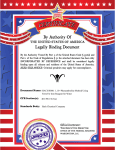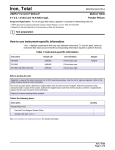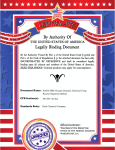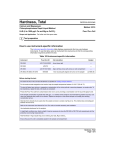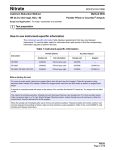Download Manual - Hach Nickel Reagent Set
Transcript
Nickel, 8037 Nickel DOC316.53.01064 USEPA1 Heptoxime Method2 Method 8037 0.02 to 1.8 mg/L Ni Powder Pillows Scope and Application: For Water, Wastewater and Seawater 1 USEPA accepted for reporting wastewater analyses (digestion required). Procedure is equivalent to Standard Method 3500-Ni D for wastewater 2 Adapted from Chemie Analytique, 36 43 (1954) Test preparation How to use instrument-specific information The Instrument-specific information table displays requirements that may vary between instruments. To use this table, select an instrument then read across to find the corresponding information required to perform this test. Table 228 Instrument-specific information Instrument Sample cell Cell orientation DR 6000 2495402 Fill line faces right DR 5000 2612602 Fill line faces user DR 3900 2612602 Fill line faces user DR 3800, DR 2800, DR 2700 2612602 Fill line faces right Before starting the test: For more accurate results, determine a reagent blank value for each new lot of reagent. Follow the procedure using deionized water in place of the sample. Subtract the reagent blank value from the final results or perform a reagent blank adjust. Make the cotton plug pea-size. A larger plug will restrict the flow; a smaller plug may become dislodged from the delivery tube of the funnel. Chloroform (D022) solutions are regulated as hazardous waste. Do not pour these materials down the drain. Water saturated with chloroform, chloroform solutions and the cotton plug used in the delivery tube of the separatory funnel should be collected for proper disposal. Refer to a current MSDS for safe handling and disposal instructions. In bright light conditions (e.g. direct sunlight) it may be necessary to close the DR 3900, DR 3800, DR 2800 and DR 2700 cell compartment with the protective cover during measurements. Collect the following items : Description Chloroform, ACS Quantity 30 mL Nickel 1 Reagent Powder Pillow 1 Nickel 2 Reagent Powder Pillow 1 Nickel Page 1 of 6 Nickel Collect the following items (continued): Description Quantity Clippers for Opening Pillows 1 Cotton Balls varies Cylinder, graduated. 10-mL 1 Cylinder, graduated, 500-mL 1 Funnel, separatory with stand and stopper 1 Sample Cells (see Instrument-specific information) 2 See Consumables and replacement items for reorder information. Heptoxime method for powder pillows Stored Programs 335 Nickel Heptoxime Start 1. Select the test. Insert an adapter if required (see Instrumentspecific information). 5. When the timer expires, add the contents of one Nickel 2 Reagent Powder Pillow to the funnel. Stopper and invert to mix. Nickel Page 2 of 6 2. Measure 300 mL of sample in a 500-mL graduated cylinder. Pour into a 500-mL separatory funnel. 3. Add the contents of one Nickel 1 Reagent Powder Pillow to the funnel. Stopper and invert to mix. 4. Start the instrument timer. 6. Start the instrument timer. 7. When the timer expires, add 10 mL of chloroform. Insert the stopper and invert gently. With the funnel inverted and the tip pointed away from people, open the stopcock to vent. 8. Close the stopcock and invert for 30 seconds. A second five-minute reaction time will begin. A five-minute reaction time will begin. Nickel Heptoxime method for powder pillows (continued) 9. Start the instrument timer. A third five-minute reaction period will begin. Invert the funnel several times over the five minute period. 10. Prepared Sample: When the timer expires, wait for the layers to separate. Insert a pea-sized cotton plug into the delivery tube of the funnel. Remove the stopper and drain the chloroform layer (bottom layer) into a sample cell. 11. Repeat steps 7 through 10 two additional times with 10-mL volumes of chloroform. The five-minute reaction period is not necessary. 12. Cap the sample cell and invert to mix the extracts. The final volume will be about 25 mL due to the slight solubility of chloroform in water. Insert the stopper into the funnel. Zero 13. Blank Preparation: Fill a second sample cell with 10 mL of chloroform. Cap the cell. 14. Wipe the blank and insert it into the cell holder. 15. ZERO the instrument. The display will show: 0.00 mg/L Ni 16. Wipe the prepared sample and insert it into the cell holder. READ the results in mg/L Ni. Interferences Cobalt, copper and iron interferences can be overcome by adding additional Nickel 1 Reagent Powder Pillows in step 3 of the Heptoxime method for powder pillows. The tolerance limits of these interferences are shown in the Interfering substances table. A preliminary acid digestion is required to determine any suspended or precipitated nickel and to eliminate interference by organic matter. To eliminate this interference or to determine total recoverable nickel perform the USEPA approved digestion. Nickel Page 3 of 6 Nickel Table 229 Interfering substances Tolerance Limit (mg/L) Pillows of Nickel 1 Reagent Cobalt Copper Iron 1 1 10 20 2 7 16 65 3 13 22 110 4 18 28 155 5 25 35 200 Sample collection, preservation and storage • Collect samples in acid-washed plastic bottles. • Adjust the sample pH to 2 or less with Nitric Acid*, about 5 mL per liter. Preserved samples can be stored up to six months at room temperature. • Before analysis, adjust the sample pH to between 3–8 with 5.0 N Sodium Hydroxide Standard Solution*. Do not exceed pH 8 as this may cause some loss of nickel as a precipitate. • Correct the test results for volume additions. Accuracy check Standard additions method (sample spike) Prepare a 300 mg/L nickel standard by pipetting 15 mL of 1000 mg/L Nickel standard into a 50 ml volumetric flask. Dilute to volume and mix well. Required for accuracy check: • Nickel Standard Solution, 1000-mg/L Ni • Volumetric Pipet, 15 mL • Volumetric Flask, 50 mL • TenSette Pipet and tips • Pipet Filler 1. After reading test results, leave the sample cell (unspiked sample) in the instrument. 2. Select Options>More>Standard Additions from the instrument menu. 3. Accept the default values for standard concentration, sample volume and spike volumes. After the values are accepted, the unspiked sample reading will appear in the top row. See the user manual for more information. 4. Use the TenSette Pipet to prepare spiked samples: add 0.2 mL, 0.4 mL and 0.6 mL of 300 mg/L standard to three 300-mL portions of fresh sample. 5. Follow the Heptoxime method for powder pillows test procedure for each of the spiked samples using the powder pillows, starting with the 0.2 mL sample spike. Measure each of the spiked samples in the instrument. 6. Select GRAPH to view the results. Select IDEAL LINE (or best-fit) to compare the standard addition results to the theoretical 100% recovery. * See Optional reagents and apparatus. Nickel Page 4 of 6 Nickel Standard solution method Note: Refer to the instrument user manual for specific software navigation instructions. Required for accuracy check: • Nickel Standard Solution, 1000-mg/L • Deionized water • Volumetric flasks, 500 mL and 1000 mL • Volumetric pipets, 10 mL and 50 mL • Pipet filler 1. Prepare a 10.0 mg/L nickel working solution as follows: a. Pipet 10.0 mL of a Nickel Standard Solution, 1000-mg/L, into a 1000-mL (1 liter) volumetric flask. b. Dilute to the mark with deionized water. Mix well. Prepare this solution daily. 2. Prepare a 1.0-mg/L nickel standard solution by diluting 50.0 mL of the 10-mg/L working standard solution to 500 mL in a volumetric flask. 3. Use the standard solution in place of the sample. Follow the Heptoxime method for powder pillows test procedure. 4. To adjust the calibration curve using the reading obtained with the standard solution, select Options>More>Standard Adjust from the instrument menu. 5. Turn on the Standard Adjust feature and accept the displayed concentration. If an alternate concentration is used, enter the concentration and adjust the curve to that value. Method performance Program Standard Precision 95% Confidence Limits of Distribution Sensitivity Concentration change per 0.010 Abs change 335 1.00 mg/L Ni 0.93–1.07 mg/L Ni 0.02 mg/L Ni Summary of method Nickel ion reacts with heptoxime to form a yellow-colored complex which is then extracted into chloroform to concentrate the color and enable a more sensitive determination. Chelating agents are added to the sample to overcome the interferences caused by cobalt, copper and iron. Readings are taken at 430 nm. Consumables and replacement items Required reagents Description Quantity/Test Unit Catalog number — — 2243500 30 mL 500 mL 1445849 (2) Nickel 1 Reagent Powder Pillows 1 25/pkg 212368 (2) Nickel 2 Reagent Powder Pillows 1 25/pkg 212468 Nickel Reagent Set (50 Tests), includes: (3) Chloroform, ACS Nickel Page 5 of 6 Nickel Required apparatus Description Quantity Unit Catalog number Clippers 1 each 96800 Cotton Balls, absorbent 1 100/pkg 257201 50838 Cylinder, graduated, 10-mL 1 each Cylinder, graduated, 500-mL 1 each 50849 Funnel, separatory, 500-mL 1 each 52049 Ring, support, 4-inch 1 each 58001 Sample Cell, 1-inch square, w/stopper, matched pair 2 2/pkg 2612602 Stand, support, 5 x 8-inch base 1 each 56300 Unit Catalog number 100 mL 1417642 4L 27256 Description Unit Catalog number Cylinder, mixing, 25 mL each 189640 Pipet, volumetric, Class A, 15 mL each 1451539 Pipet, Volumetric, Class A, 50 mL each 1451541 Flask, Volumetric, Class A, 500 mL each 1457449 Flask, Volumetric, Class A, 1000 mL each 1457453 Recommended standards Description Nickel Standard Solution, 1000-mg/L Ni (NIST) Water, deionized Optional reagents and apparatus Flask, Volumetric, Class A, 50 mL each 1457441 Pipet Filler, Safety Bulb each 1465100 Nitric Acid 1:1 500 mL 254049 Sodium Hydroxide Standard Solution, 5.0 N 100 mL 245053 each 1451538 Pipet, volumetric, 10 mL FOR TECHNICAL ASSISTANCE, PRICE INFORMATION AND ORDERING: In the U.S.A. – Call toll-free 800-227-4224 Outside the U.S.A. – Contact the HACH office or distributor serving you. On the Worldwide Web – www.hach.com; E-mail – [email protected] © Hach Company, 2007, 2010, 2012. All rights reserved. Printed in the U.S.A. HACH COMPANY WORLD HEADQUARTERS Telephone: (970) 669-3050 FAX: (970) 669-2932 Edition 7






